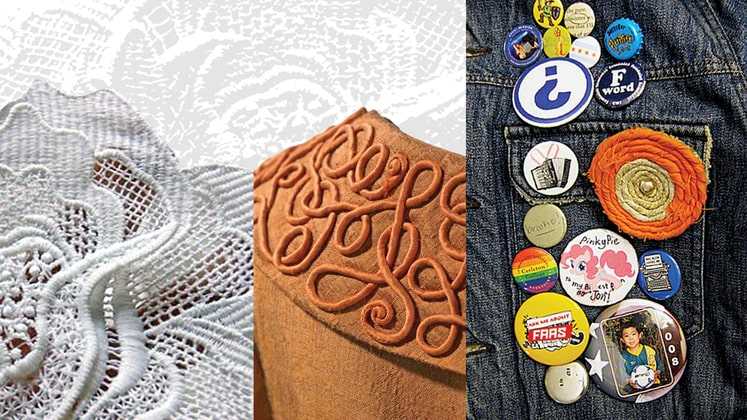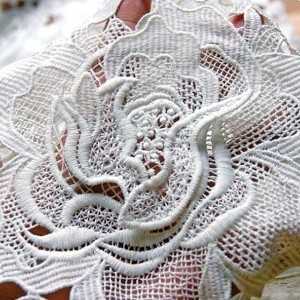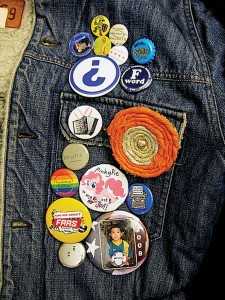
A garment is incomplete till the time it is not finished with trims, closures and accessories; interestingly in the quest of being creative, trims have become a crucial design element as well. Starting off as just a functional viability in a garment, the regular ribbons, laces, cords, buttons and zippers can now be seen as surface ornamentation in assortment of designs and patterns. Driven by innovation, these value-added accessories are ruling the fashion shows and are predicted to continue impressing the world by their innovative design concepts and applications in the upcoming seasons as well…
Creativity has no boundaries, and it can be executed with the simplest of trims as well. Buttons in all shapes are being put together in a collage to create various textures, for example in sleeve vents and collars. Be it covering the entire surface area of a jacket or linked together to form a mesh like structure, buttons in a wide range of materials like bone, horn, ivory, shell, wood, glass, metal and Bakelite are used to achieve the desired look. Grommets, reinforced eyelets and rivets are garnished all over in chaotic and scattered arrangements. With metal, polyester and moulded zippers available, the decorative value of this category has definitely increased. Zippers with rainbow colour teeth, two-way sliders; coveralls, treated with various metal finishes are a major hit with the masses.

The Spring/Summer and Pre-Fall’14 runways also witnessed countless possibilities of trim applications illustrated by designers. Hervé Léger by Max Azria used zippers to control dress silhouettes creating conceal-and-reveal apertures (zip down for a fitted skirt, zip up for flare) and ruffles within the dress itself whereas on the other hand Jeremy Scott played with zipper sizes and placements on the front panel of dresses, tops and trousers. Honor, Lela Rose and Wes Gordon experimented with cutout lace, in the form of appliqué and patchwork with the base fabric in distinctive eye-catching patterns. Christopher Kane re-created the effect of a delicate viral web in Swiss lace and inserted the result in a floral pattern with finesse in the evening dresses. A wide-ranging variety of macramé, parachute, fabric and leather cords were positioned in patterns and were incorporated with metal components for an individual standout look in Balmain, Mark Jacobs and Dion Lee collections. Featuring a cage like structure over the skirt and a lace corset, Thom Brown presented an amalgamation of appliqué and cording.
Variations in Trim application by exporters…

With increasing demand of value-added garments in the export market, designers are experimenting with trims to make their garment appealing and at the same time practical to sell as well. Be it garments, bags, shoes or home accessories, buttons, rivets and laces, all are being used in a mish mash of colours, sizes and materials to provide a unique combination of innovation and saleability. Some of the interesting applications by fashion forward companies are detailed below.
Buttons and Rivets…
Darshika Sharma, Executive Merchandiser, Apollo International Buttons and rivets are an integral part of our designing. Mostly doing Bomber and Biker leather jackets, we use silver, gold, brass metallic buttons in various shapes to give a designer edge. A button has four parts A, B, C, D, but we use two parts only, A and B, for the decorative purpose. We put the buttons in groups, or create a design with different placements. In skirts, we do interlacing with eyelets and rivets. We box pleat the leather and place the rivets in the in-fold, so that the design is only partially visible. Now studded and shank buttons are being used as a replacement to beads, for heavy embellishments in the back yoke, shoulders, cuffs and pockets. Leather is cut and coiled to create a surface texture and different rivets are sprinkled around to add on to the look. The Russian market that we work in does not experiment so much, but they require very fancy trims, therefore we mostly work on shapes and textures of buttons and rivets.
Sandip Kumar, Assistant Designer, Jayshree International
We use different types of plastic buttons, wooden, stone, handmade buttons and textured buttons to create new looks. For a style being created for Zara, we are creating surface texture by buttons, first we are moulding and manipulating fabric with different stitches to create a textured button and then we are placing these buttons in a certain way to create a high-low level texture surfacing. Instead of using a regular one, we take a really thin button, create a 3-4 inch texture on top of it, using different materials like, fabric, sequin, beads, etc. and then the same button of different sizes is used to create a surface.
Sonam, Designer, Elisha W
The trims and value addition that we work on mostly is heavy and blingy. We create various metallic, transparent and sequin buttons. We also create different ornamentations through buttons, for example, for a style right now, we are taking very thin plastic circular buttons and using a dryer we heat the plastic elements and mould it according to the requirement in different shapes, and then we scatter it all over the fabric to achieve a fish-scale like surface. We have made an entire jacket using multi-sized and multi-coloured buttons. We have created a dress in which the bust part, is fully covered with buttons of different sizes in ombre for our summer collection. Our most prominent buyers are Armani, Prada and Zara.
The Pull of Stylish Zippers… Apollo International
Zippers are major value additions for our garments. Generally we do garments with zipper tapes exposed, so that the tapes add on to the look of the garment. We experiment a lot with the types of tapes used in zippers. At times we use cotton tapes as cotton shrinks after wash that gives a nice crinkling effect to the edges of the garment. Multi-coloured tapes, especially florescent colour tapes are being used. We are very particular about the kind of teeth of the zip, metal, moulded, and coiled teeth being used. We patch zippers with sheer fabrics and create a long length tape to be used in collars and cuffs. We are also very cautious about the finishes given to the zippers. Metallic finishes, nickel finish, gun-metal finish, black-matte finish. Zippers attached in the same garment are given various washes and are layered to get a metallic ombre effect.
Goonjan Kumar, Designer, JJ Expo Impo
We have created an entire dress made with zippers. We make flowers, ruffles, entire cowls and collars out of zippers. Different finishes are applied to different zippers and then they are put together in overlapping style to create a layering effect. Zippers are used to make patterns on the garment by coiling and intertwining. Embellished collars and front panels are being created entirely by manipulating zips. We play with placements of zippers in jackets and trousers, for instance, one is a functional pocket while other zippers are for decorative purpose. We often use zippers layered together in the back yoke area without the sliders.
The Sheer World of Lace … Jayshree International
We are working with DKNY, Armond Ferri, and for them we are using different types of laces in cotton, linen, silk, gold, or silver threads. The laces are used as ruffles, pleats and are even modified into flowers or are patched with base fabrics. We also cut-out motifs from a lace fabric and appliqué them over the base fabric, mostly in contrast, for example, blue or black lace cut-out on white fabric. Small sized lace flowers are laser cut and tucked over a lace fabric to get the right-now popular 3-D flower look. We are also combining different types of laces together and panelling them over a net fabric, to achieve a lace on lace effect. Lace and cording is being used together for creating interesting dress panel.
Arjun Sehgal, Head Designer, Mariko
We are using translucent, see-through fabrics, to patch the cut-outs of the various GPO laces. This is something interesting we are doing; in the same garment we are using cut-work. Garment at certain places is cut in a particular pattern and is backed by a georgette or crepe fabric, patched with lace motifs. Basically we want to use our designer brain in such a way that we do innovation to cater the export oriented orders that are booked on innovation. The GPO lace we are using is a heavy variety and is 600-700 rupees per metre, so we use it for a particular clientele only.
Taping and Cording…
Jayshree International
We use different varieties of cords like macramé, spiral, rope-like, cords with tassels, etc. We are doing a few styles for Zara, which involves a lot of cording on neckline. Cording is no more used only for piping or edging; it is being braided, moulded, twisted and stitched in a pattern on jackets and other garments. We use cording to create roulleau fasteners also, wherein the cord is stitched first in a pattern and continues to become fastener near the placket. Tapes are folded and tucked like a 3-D flower with help of a button for creating 3-D surfaces. Tapes are also gathered and stitched as edgings of motifs on garments. We are also making buttons out of coiled circular discs and using them on jackets and tops.

Post a Comment